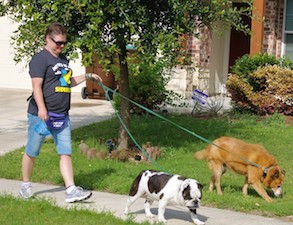There has been a rise in the number of pet friendly workplaces in recent years as businesses realize the benefits to productivity and morale that allowing employees to bring their pets to work can provide.
Table of Contents
Introduction
This article explores the idea of pet-friendly workplaces and offers helpful information for those considering taking their pets to work with them. The benefits are numerous and varied, including but not limited to less stress, improved creativity, more meaningful social relationships, and more productivity at work. The article also includes examples of businesses that have adopted pet-friendly policies and discusses the factors to think about and best practices to follow when creating such a policy.
Benefits Of Pet Friendly Workplaces

The workplaces of today are fast-paced and competitive, so businesses are always looking for new ways to motivate their workers and increase their output. Pet friendly workplaces, where employees are encouraged or even required to bring their pets to work, are a growing trend. This innovative strategy has many positive effects on people’s lives, including improved stress levels, happiness, job satisfaction, creativity, social interaction, work-life balance, and even physical health. To further understand the compelling benefits of adopting pet-friendly regulations, we’ll delve into these numerous facets throughout this article.
Mental Health
High levels of stress and pressure in today’s workplaces are a common cause of burnout and a decline in mental health. Pets in the office have been shown to have significant effects on both stress levels and mental well-being. The release of oxytocin, a hormone related to bonding and stress alleviation, is responsible for the therapeutic effects of pet interactions like petting a dog or cat, which have been the subject of several studies. By providing a distraction from the stresses of the workplace, providing pets for employees is a great way to help them relax and feel more at ease. Pets not only make the workplace more pleasant, but their very presence acts as a natural stress buffer.

Worker Happiness and Retention Rates Rise
Having happy workers is crucial to running a successful business. Employees report much higher levels of satisfaction at pet friendly workplaces. If workers are permitted to bring their pets to the office, they will feel more at home there, which will boost their devotion and dedication to the company. As a result of the good effect on job satisfaction, the costs of recruiting and training new employees are reduced. By introducing pet friendly workplaces, companies show they care about their workers in more ways than just the office environment.
In today’s competitive business environment, the ability to think creatively and innovatively is vital. The novelty and spontaneity introduced by having pet friendly workplaces can have a significant impact on employees’ ability to think outside the box. Employees can take mental breaks to interact playfully with the creatures, which has been shown to improve concentration and creativity. These brief periods of happiness have been linked to gains in cognitive flexibility, openness to new ideas, and originality in general. In addition, the uplifted disposition and increased drive that result from time spent with pets might boost work performance.
Interpersonal Skills and Group Dynamics
Animals like dogs and cats have a natural way of bringing people together and removing barriers. In a pet friendly workplace, employees are more likely to talk to one another since they can easily find common ground with their pets. These kinds of activities foster friendship and bonding among workers, which in turn improves teamwork and cooperation. Petting a dog or playing with a cat can lead to unplanned talks between coworkers from different departments, which can improve teamwork and morale. Group walks or other pet-related events are great team-building exercises since they foster camaraderie and the sharing of experiences.
More Time for Personal Activities

Employees consistently struggle with juggling work and personal responsibilities. Having pets at work is a novel approach that can help people achieve a better work-life balance. When they have to leave their pets alone for long periods of time, many pet owners face feelings of guilt and anxiety. The freedom to bring pets to the workplace removes this stress, letting workers focus on both their work and their pets’ demands. Having that constant companionship and bond during the workday promotes peace of mind by relieving the pressure of juggling work and pet care.
Physical Health

The benefits of pet friendly workplaces go beyond the emotional wellness of employees. Walking or playing with your pet during breaks at work is a great way to get some exercise and relieve stress. These breaks are much-appreciated reprieves from sitting at a computer all day and beneficial to heart health in general. Pet ownership has also been linked to reduced heart rates and blood pressures, which may help reduce the likelihood of cardiovascular disease. A more robust and energized workforce is a direct result of pet friendly office rules that encourage exercise and a positive work atmosphere.
According to Science
Animals have always been an integral part of human life, and this has been true across time, space, and culture. Extensive scientific study has focused on this one-of-a-kind and profound connection, which is commonly known as the human-animal relationship. Studies have demonstrated that having pets can have significant positive effects on people’s emotional, mental, and even physical health. Focusing on the strength of the human-animal link, hormonal and neurological responses to pets, and the psychological benefits of pet interaction, this article explores the scientific basis for how pets enhance human well-being.
The Human-Animal Connection

The human-animal bond is complex, including feelings of love, trust, and emotional support between the two parties. Humans and nonhuman animals have shared the planet for a long time, and we depend on each other for both survival and companionship. This is especially true in the modern-day connections between pets and their owners, where they have become a source of emotional comfort and companionship.
The emotional health of humans is greatly improved by the companionship and unconditional love of pets. This connection can protect both parties from the negative effects of stress, loneliness, and isolation, boosting the recipient’s emotional well-being.
Our Hormonal and Nervous Systems
Positive emotions and a sense of well-being are produced by the release of endorphins and other hormones when people interact with animals. During pleasant social interactions, such as those between humans and their pets, both humans and animals emit oxytocin, also known as the “love hormone” or “bonding hormone.” Feelings of attachment and emotional warmth can be stimulated by petting a dog, hugging a cat, or even just being in the company of a loving pet. This hormone reaction helps people feel more emotionally connected and less stressed.
Other neurochemicals, including dopamine and serotonin, are also released in response to interactions with dogs. These neurotransmitters are crucial for controlling feelings and dispositions. Feelings of joy, satisfaction, and contentment are linked to elevated levels of the neurotransmitters dopamine and serotonin. Thus, the simple act of engaging with dogs can cause an increase in these neurochemicals, leading to a more upbeat emotional state and a more generally healthy state of mind.
Emotional Management

The positive effects of a pet friendly workplace extend to many facets of mental health. The alleviation of stress and anxiety is a noteworthy advantage. Stress hormones like cortisol are reduced when people spend time with pets by playing, stroking, or even just observing their behavior. In today’s fast-paced and demanding society, where chronic stress is a frequent worry, the ability to reduce stress is more important than ever.
In addition, interacting with pets has been linked to better emotional management and mood. Possessing a furry friend can improve your mood and make you feel more relaxed and at ease. Pets may be a great source of emotional support and companionship, especially during trying times, since studies have shown that interacting with pets can reduce depressive and anxious feelings, making pet friendly offices a harmonious place to be.
Pets play a key role in helping people connect with one another in the world of social interactions. Improved feelings of worth, acceptance, and contentment with one’s life might result from these pet friendly offices.
Real Life Examples Of Pet Friendly Offices
A pet friendly workplace has gone beyond being a novelty to become a strategic strategy for improving morale and productivity. Several major corporations have led the way in this movement, demonstrating the concrete gains to be had from allowing employees to bring their pets to work with them. In this piece, we look at real-world examples of companies that have implemented pet friendly offices with great results, including Amazon, Google, and Ben & Jerry’s.

Amazon Promotes a Community That Loves Pets
Amazon, the world’s largest online retailer, is well-known not only for its cutting-edge methods of doing business but also for its forward-thinking approach to company culture. Amazon appreciates the value its employees have for their pets and the positive impact they may have on the company’s culture. That’s why they have pet friendly office policies, so workers may bring their pets to the office with them.
Amazon’s attention to pet-related amenities is a shining example of the company’s pet friendly workplace culture. At the company’s Seattle headquarters, canine companions are welcome to join their human coworkers in the great outdoors in specially designated dog parks and play spaces. By providing areas where employees may bring their pets, Amazon is demonstrating its dedication to creating an atmosphere where workers can prioritize both their professional and personal needs.
Amazon’s pet friendly workplace culture has had a positive effect, as evidenced by the enhanced sense of community among workers. Dogs are great icebreakers in the workplace because they get people talking to each other who otherwise might not. Employees are more likely to share ideas and work together on projects as a result of these conversations. Amazon has improved its work environment and fostered a strong sense of community and well-being among its employees by adopting a pet friendly workplace culture.
Google’s Pet Friendly Offices
When it comes to progressive companies that have pet friendly offices, Google is right up there with the best of them. The Googleplex, the company’s headquarters, has become widely known for the casual and innovative atmosphere it fosters among its employees. As part of this strategy, encourage pets presence in the office.
Google’s pet friendly workplace rules go beyond simply tolerating pets in the workplace; instead, they seek to incorporate them into the company’s culture and operations. There are dedicated outside areas, pet relief stations, and even in-house pet grooming services available for the convenience of customers with pets. These perks show that Google is serious about making the workplace a place where pets are not merely accepted, but thrive.
Google’s attitude toward encouraging a healthy work-life balance is consistent with the inclusion of dogs in the workplace. While working on challenging tasks and engaging in innovative brainstorming sessions, employees can take comfort in the company of their dogs. Google’s success in attracting and retaining top personnel can be attributed in part to the company’s dedication to fostering a people-focused and pet friendly workplace.
Workdays with Ben & Jerry’s are Positively Sweet
Ben & Jerry’s, the famed ice cream company, is notable for its offbeat and employee-centered approach to the workplace. Its Vermont headquarters is known for its “positively sweet workdays,” during which staff are permitted to bring their pets to work. Ben & Jerry’s appreciates the benefits pets can provide to its employees in terms of reduced stress and improved morale. The company is harnessing the positive effects of the human-animal bond by letting dogs into the office. Having the opportunity to spend time with their dogs during breaks has been shown to improve workers’ mental health and well-being.
The company’s pet friendly workplace policy reflects its dedication to encouraging a lighthearted and innovative atmosphere. The presence of dogs helps create a casual and friendly workplace where people feel safe expressing themselves and forming genuine connections with one another. Employee morale has improved because to Ben & Jerry’s open and supportive work environment, and the company’s ideals and philosophy have found favor with customers.
Pet-Friendly Workspaces Near Me in the USA
Finding a pet-friendly workspace can be a game-changer for pet owners who want to bring their furry friends to work. These spaces not only allow you to work alongside your pet but also provide a welcoming environment for both you and your companion. Here are some of the top pet-friendly workspaces across the USA:
Top Pet-Friendly Workspaces
| Workspace Name | Location | Features | Contact Information |
|---|---|---|---|
| Second Home | Los Angeles, CA | Urban jungle setting, wellness events, pet-friendly staff | Website |
| Work & Woof | Austin, TX | Doggie daycare, indoor/outdoor seating, enrichment activities for dogs | Website |
| BoxJelly | Honolulu, HI | Community-focused, panoramic views, natural light-filled workspace | Website |
| Helix Workspace | New York, NY | Flexible workspace, virtual offices, high rating | (212) 588-1700 |
| SaGE Workspace | New York, NY | Shared offices, affordable plans, Midtown South Manhattan location | (212) 683-9100 |
| Premier Workspaces | New York, NY | Furnished coworking spaces, enclosed day offices, meeting rooms | (212) 292-4444 |
| Kleverdog | Los Angeles, CA | Flexible memberships, studio desks, dog-friendly policies | Website |
Implementing A Pet Friendly Workplace Policy
Factors to Think About for Making People and Their Pets Get Along
Pet friendly offices are becoming increasingly popular as businesses see the many positive outcomes that may result from allowing employees to bring their pets to work with them. However, a well-thought-out strategy is essential for enforcing a pet friendly office, as it is crucial to the successful implementation of a pet friendly office.
Evaluating Readiness for the Workplace

It’s important for businesses to take stock of their preparedness before setting out on the path to becoming a pet friendly workplace. It is important to consider the office’s layout, infrastructure, and current regulations before deciding whether or not to adopt a pet friendly workplace policy. For instance, open floor plans with lots of room and quick access to greenery are preferable to cramped cubicles when it comes to housing pets. In order to make the move to pet friendly offices as easy as possible, it is important to conduct a thorough assessment to identify potential problems.
Establishing Norms and Standards

The foundation of a good pet friendly workplace policy is clear and thorough instructions. Pet owners and those without pets alike will benefit from the clear expectations laid out in these regulations. Pet owners may be subject to regulations about vaccines, grooming, and trash removal. Non-pet-owner standards should also take into account factors like allergies and limits. With clear guidelines in place, businesses can foster an atmosphere that is both pet-friendly and well-managed.
Health Issues and Allergies

Addressing allergy and health concerns is a top priority when creating a pet friendly workplace policy. Pets are a source of joy for many people, but for those with allergies or respiratory issues, they can be a real problem. To address these issues, several workplaces have implemented pet-free zones. In these regions, workers won’t have to worry about triggering their allergies, so they can get their jobs done without interruption. It is crucial that all employees are aware of the presence of these areas and where they may be found.
Adjustments for a Variety of Pets

A diversified workforce means a wide range of preferred pets, from canines and felines to guinea pigs and finches. A pet friendly workplace policy that works must welcome all breeds and sizes of pets. However, taking into account the individual demands and potential repercussions of employees with various pets is essential for accommodating them. Some animals, like dogs, may benefit from trips outside, while others, like birds, may demand a more tranquil environment. Businesses need to find a way to accommodate employees who bring pets to the office without sacrificing productivity or employee morale.
Designating Specific Areas for Pets
In order to keep the office neat and tidy, designated pet areas are required. In addition to comfortable indoor environments, pets need access to outdoor areas for play and relaxation. Separate spaces for pets help keep things calm and make sure animals aren’t trespassing in people-only zones. Having designated areas makes it easier to keep pets clean and dispose of their excrement. Organizations can do more to make their workplaces welcoming to pets and their owners by allocating space specifically for them.
Problems That May Come Up with Pet Friendly Offices
While the case for pet friendly offices is strong, it’s important to consider and answer any concerns that may be raised by allowing pets in the workplace. The success of a pet friendly workplace policy depends on meeting the demands of both pet owners and others who choose to avoid contact with animals while also guaranteeing a safe environment and polite behavior from all parties involved. Four major obstacles that businesses may face in pet friendly workplaces are discussed here, along with suggestions for overcoming them: noise and disturbances; liability and safety concerns; respect for those who don’t enjoy the company of animals; and conflict resolution.
Disturbances and Noise

Dogs in particular are great office companions, although they can be a distraction due to their barking and general rambunctiousness. Workers’ focus and productivity may suffer if they are constantly interrupted by barking dogs, whining children, or other such distractions. Organizational policies addressing noise levels and pet behavior may help alleviate this problem. The noise problem can be reduced with the help of pet training and socialization programs. The problem of distractible pets at the workplace can be ameliorated by designating quiet areas where animals are forced to remain quiet at all times.
Risks and Safety Considerations

Bringing pets into the office raises serious safety and liability issues. Businesses need to take precautions to make sure animals won’t harm their workers or customers. This entails identifying potential risks, such as loose rugs or hostile coworkers, and installing safety measures to mitigate them. Risks to public safety can be reduced by mandating behavior evaluations and training for household dogs. Furthermore, businesses should have liability insurance that covers situations involving pets. Organizations may ensure the wellbeing of both dogs and people by prioritizing safety measures and engaging in proactive risk management.
Acknowledgement of Pet-Free Pet Owners

Many workers may welcome the concept of pet friendly workplaces, but it’s important to be sensitive to those who don’t share this passion. Some people may experience discomfort being around animals because of fears or allergies. In order to provide a welcoming atmosphere for all employees, businesses should designate specific areas where animals are not permitted. Pet-phobic people will appreciate well-marked and clearly communicated pet-free zones. Additionally, honest communication between pet owners and people who don’t like pets can facilitate understanding on both sides and allow for preventative measures to be taken.
Avoiding Future Conflict
Even at pet friendly workplaces, disagreements between workers are possible, as they would be with any policy. Disagreements may arise over a variety of topics, including pet behavior and the appropriateness of certain areas. Organizations need a well-defined and impartial procedure for resolving conflicts if they are to address them effectively. Human resources (HR) professionals, open dialogue, and mediators may all play a role in this process. A positive work environment is maintained for all when problems are addressed promptly and resolved openly.
Change To Pet Friendly Workplaces To Go Smoothly

The move towards a pet friendly office culture is an exciting one that can have positive outcomes for both workers and their pets. However, organizations must carefully and intelligently negotiate this change to guarantee a smooth and effective adoption. In this piece, we examine key strategies for easing the shift to a pet friendly workplace, such as conducting staff surveys and getting feedback, building strong lines of communication and education, pet-proofing the office, and forming connections with local veterinarian facilities.
Note: There might be affiliate links mentioned here. We may receive a commission if you purchase a product through an affiliate link. There is no additional charge for you. Please do your own research before making any online purchases.
Opinion Polls and Responses from Workers
Organizations can use staff surveys and comments to measure interest, preferences, and concerns before making the transition to a pet friendly workplace. Employees are more likely to give honest feedback in anonymous surveys. By conducting these polls, businesses can learn useful information about their employee pet populations, including the number of pet owners, the types of pets they keep, and any potential issues that may occur. Employees will feel more invested and included in the decision-making process if the pet friendly workplace policy is based on their feedback and hard evidence.
Media, Education, and Training

A successful shift to a pet friendly workplace hinges on open and honest communication between all parties involved. A clear approach for informing staff of the new policy, standards, and expectations should be established by each organization. This may be done via email, in-person meetings, or company-wide bulletins. The tone for a peaceful pet-friendly community can be set by providing instructional materials on responsible pet ownership, pet etiquette, and behavioral rules. In order to keep the office environment pleasant for dogs and coworkers, personnel need to be well-informed and educated.
Preparing the Workplace for Pets

Making the workplace safe for pets is important for the well-being of both pets and workers. To “pet-proof” an office, one must first assess the area for potential dangers and then take measures to eliminate or reduce them. Things like making sure there are no dangling cords, getting rid of poisonous plants, and using pet-friendly furniture and appliances at the workplace are all examples of this. Water stations, trash cans, and comfy seating should all be easily accessible in pet play spaces. When businesses take the time to “pet-proof” their offices, they make it easier for pet owners to bring their animals to work with them.
Agreements with Animal Hospitals and Clinics

Both pet owners and those who don’t have pets at work can benefit from establishing ties with veterinary services. By teaming up with nearby vet clinics or pet care providers, employees can easily schedule appointments for consultations, exams, vaccines, and even training. Together, we can make a difference in our pets’ lives and in the lives of their owners by forming these partnerships. In addition, by providing services for pets, the business exhibits its dedication to making the community a healthy and welcoming place for pets.
Maintaining a Legal and Moral Foundation for Pet Friendly Workplaces
As more and more businesses adopt pet friendly workplace policies, it’s important to understand the various legal and ethical ramifications of doing so. Although there are many upsides to pet friendly workplace policies, businesses should check to make sure they comply with the law and are ethical. The Americans with Disabilities Act (ADA) and service animal accommodations, promoting diversity and inclusion, and striking a balance between employee preferences are all discussed in detail here.
Accessible Design and Service Animals

To a large extent, the rules for allowing service animals into the workplace have been shaped by the Americans with Disabilities Act (ADA). Dogs that have been trained to assist people with impairments are considered service animals. Some examples of such work include serving as guides for the visually impaired, sounding alarms for the hearing impaired, or helping those with mobility issues.
The Americans with Disabilities Act (ADA) protects the rights of people with disabilities by ensuring that they are afforded equal access to public and private accommodations, including workplaces. Employers have a legal responsibility to make reasonable accommodations for workers who use service animals due to a disability. For service animals to be fully functional in the workplace, policies and physical environments may need to be adjusted. In order to comply with the ADA and foster an inclusive workplace for employees with disabilities and their service animals, it is essential for businesses to become knowledgeable about the Act’s rules and guidelines.
Guaranteeing Equal Access
All employees should be treated equally under a pet friendly workplace policy, regardless of whether or not they own pets. There are many advantages to having a pet friendly workplace, but it’s important that employers not create a culture that favors pet owners over those who don’t. It’s important to meet the demands of pet owners without neglecting those of people who are allergic to or otherwise uncomfortable with animals.
Clear policies prohibiting discrimination based on pet ownership can help organizations provide equal opportunity for all members of the community. Non-pet owners can work in peace in designated pet-free zones within the office, where they are not exposed to potential allergens or animals. By encouraging a welcoming atmosphere, businesses may ensure that all workers are treated fairly and avoid unpleasant confrontations.
Finding Common Ground With Workers

Finding a happy medium between pet owners and those who don’t own pets can be a challenging task. Pet-friendly rules can improve workers’ health and happiness on the job, but employers should be cautious not to violate the rights of those who are allergic to animals. The key to finding this equilibrium is good communication and teamwork.
Organizations can gauge workers’ preferences and concerns by holding open dialogues and soliciting feedback from them. Employee surveys, focus groups, or town hall meetings are all good ways to get a feel for the range of opinions in the workplace. With input from workers, businesses may craft pet friendly workplace policies that are fair to all employees while still reflecting the group’s priorities.
Conclusion
Pet friendly offices are an innovative way for businesses to prioritize their employees’ happiness and productivity. Pet friendly offices have effects on more than just employee morale; they can also reduce stress, boost productivity, and inspire innovation. To capitalize on the benefits of employee connection with pets, businesses should familiarize themselves with the research behind the human-animal bond and adopt reasonable regulations and procedures.
FAQs
The concept of pet friendly workplaces is growing in popularity, but what exactly are they?
Companies that are “pet-friendly” let workers bring domestic animals like dogs and cats to work with them. The positive effects that pets can have on workers’ health, happiness, and productivity have led to a rise in the number of businesses that welcome them.
What do pet friendly offices have to offer their workers?
Stress is decreased, job satisfaction is increased, creativity and productivity are increased, social interaction and team building are bolstered, work-life balance is improved, and physical health is improved thanks to pet friendly workplaces.
In what ways might pet friendly offices alleviate tension and boost morale?
Petting a dog or cat, for example, can cause a surge in oxytocin, a hormone linked to feelings of calm and closeness. The natural stress buffer that pets provide can make the workplace more pleasant for everyone.
How do pet friendly offices improve morale and help keep workers around?
Employees who are allowed to bring their pets to work report higher levels of happiness and satisfaction in their work lives. Having employees who are able to bring their dogs to work has been shown to increase loyalty and commitment to the company.
How do you think having a pet helps you be more innovative and productive?
Pets are a great way to liven up the office and encourage innovation. Taking brief breaks to play with your pet has been shown to boost your ability to solve problems, open your mind to new ideas, and stimulate your creativity. Positivity induced by interacting with pets has been shown to improve both mood and motivation, leading to increased output.
In what ways do pet friendly offices promote communication and cooperation among workers?
Pets are great icebreakers, helping coworkers from different teams bond through a shared interest. Teamwork and cooperation are improved by participation in pet-related activities like group walks and other social gatherings.
How do pet friendly offices help employees find a better balance between work and personal lives?
Bringing pets to the office reduces the sadness and worry associated with abandoning them for long periods of time. A better work-life balance is achieved, and the stress of juggling work and pet obligations is reduced, when employees are able to feel a sense of companionship and connection with their pets during the workday.
Are any physical benefits attributed to the presence of pets at the workplace?
Short breaks for walks or play sessions with a pet are great for getting some exercise and improving cardiovascular health. Research has also shown that having pets in the workplace can reduce stress and improve cardiovascular health.
What effect does the link between humans and animals have on happiness?
Intense feelings of love and support are shared between humans and their animal companions. The release of the feel-good hormones oxytocin, dopamine, and serotonin during positive interactions with dogs has been linked to increased happiness, decreased anxiety, and better overall health.
How can businesses prepare for the difficulties associated with pet friendly office policies?
Guidelines for noise management, safety measures to reduce liability risks, pet-free zones to accommodate people who prefer not to be around animals, and an equitable dispute resolution process should all be established by organizations. Following these measures guarantees peace and tranquility in pet-friendly spaces.


































































































































